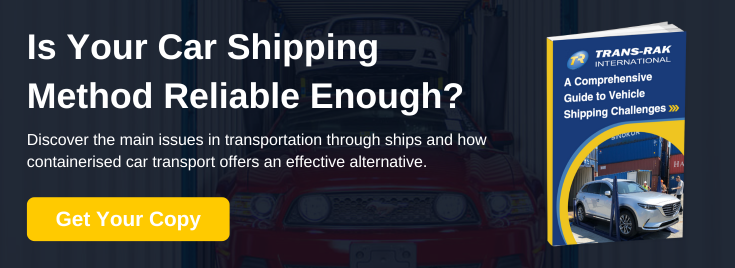
One of the main reasons that automotive logistics businesses cite for choosing Ro-Ro (roll on, roll off) transport over containerised shipping for finished vehicle logistics is that Ro-Ro is cheaper and easier to arrange due to the large availability of Ro-Ro vessels.
This has been a big factor over the last couple of years, with wild fluctuations in container shipping price and availability making containerised transport a risky proposition for many transport businesses and OEMs.
Decrease In Ro-Ro Capacity For Vehicle Shipments
Since summer 2022, however, the global availability of Ro-Ro ferries for large international car consignments has dropped considerably, leading to a worldwide increase in unit rates and transport delays in some areas.
This shift has put containerised shipping back on the table as a realistic proposition – especially with the dramatic fall in shipping container prices over the same period. At the same time, dedicated container racking systems are now being used by multiple high-profile OEMs, including Tesla, for the transportation of electric vehicles (EVs), significantly raising the credibility of containerised transport as a viable option.
Containerised car transport – although traditionally more expensive – offers more flexibility with fewer restrictions compared to Ro-Ro vessels, making it attractive for businesses unable to secure additional Ro-Ro capacity on pure car/truck carriers (PCTCs).
What are the reasons behind this unexpected market shift, and what does the ‘Ro-Ro drought’ mean for automotive logistics businesses in 2023?
Fewer Ro-Ro Ferries Currently In Service
The global decrease in Ro-Ro capacity is primarily due to several high-capacity commercial vessels being returned from long term charterers (currently inactive) and an imbalance between supply and demand. As is often the case in automotive logistics trends, the current issues arise from fluctuations in the Chinese market; in particular the growth of the Chinese finished vehicle export market.
Growth Of Chinese Finished Vehicle Exports
Chinese finished vehicle exports to America and Europe have been steadily increasing over the past few years. In 2020, despite the pandemic, there was an 8% increase from 2019, with 1.1 million cars exported worldwide, primarily to EU countries such as Germany, Italy, France, Sweden, and Norway. This trend looks set to continue with production output expected to reach 1.5 million units per year by 2025 according to Bloomberg NEF estimates. These exports have largely cornered the Ro-Ro market, driving up prices and demand outside of China.
Market Uncertainty & Vessel Investment Woes
Additionally, the current market uncertainty, combined with low numbers of new Ro-Ro vessels on order for delivery in 2023, have made it problematic for owners and operators alike when it comes to investing in new or second-hand tonnage. Softening spot rates between Shanghai and Northwest Europe have also made container shipping more attractive for OEMs and logistics businesses, due to the lower costs offered by container ship operators servicing the Asia – Europe sea lanes. These are currently approximately 40% cheaper than Ro-Ro routes according to data from VesselsValue Price Index (VPI).
Transporting Electric Vehicles By Container Ship
Electric vehicles have numerous logistics restrictions and considerations in place that don’t affect their internal combustion-powered counterparts, notably the widespread requirement that the battery be removed or run down before the vehicle can be embarked at port. Container shipping, in contrast, has fewer barriers to market, such as French operator CMA CGM’s more liberal restriction that EVs must be declared dangerous goods only when moved via reefer (refrigerated) containers with 40% battery charge or more at time of loading. EVs shipped in standard shipping containers with the battery removed and stored separately (as is possible with either an external or internal loading racking system) are not subject to any shipping restrictions.
“1 million+ vehicles will be containerised from China in 2023.” - VesselsValue
Find Out More
Trans-Rak provide a range of cost-effective containerised racking systems to help improve the economy of finished vehicle logistics for all types of vehicles, including EVs. If you’d like to find out more about the comparative costs of containerised car transport vs Ro-Ro, and how to get the best results for your budget, please call 01926 408282 today.
Image source: Canva
















